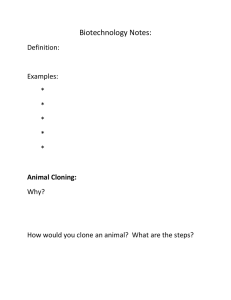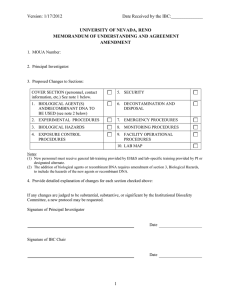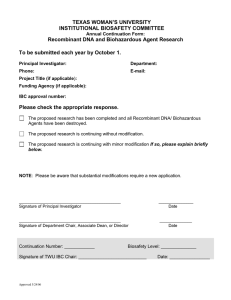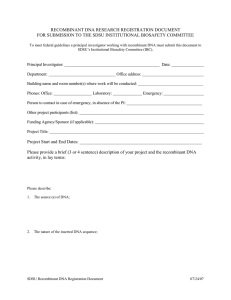Form 01: Initial & Triennial Registration (MS Word)
advertisement
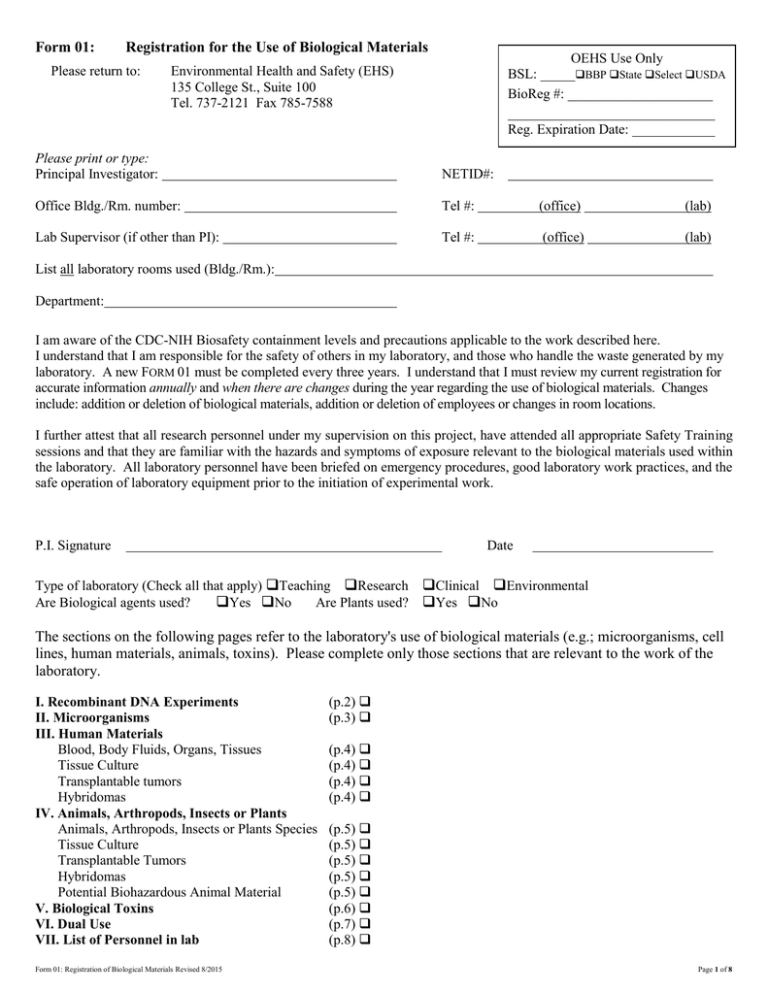
Form 01: Registration for the Use of Biological Materials Please return to: OEHS Use Only BSL: _____BBP State Select USDA BioReg #: _____________________ ______________________________ Reg. Expiration Date: ____________ Environmental Health and Safety (EHS) 135 College St., Suite 100 Tel. 737-2121 Fax 785-7588 Please print or type: Principal Investigator: NETID#: Office Bldg./Rm. number: Tel #: (office) (lab) Lab Supervisor (if other than PI): Tel #: (office) (lab) List all laboratory rooms used (Bldg./Rm.): Department: I am aware of the CDC-NIH Biosafety containment levels and precautions applicable to the work described here. I understand that I am responsible for the safety of others in my laboratory, and those who handle the waste generated by my laboratory. A new FORM 01 must be completed every three years. I understand that I must review my current registration for accurate information annually and when there are changes during the year regarding the use of biological materials. Changes include: addition or deletion of biological materials, addition or deletion of employees or changes in room locations. I further attest that all research personnel under my supervision on this project, have attended all appropriate Safety Training sessions and that they are familiar with the hazards and symptoms of exposure relevant to the biological materials used within the laboratory. All laboratory personnel have been briefed on emergency procedures, good laboratory work practices, and the safe operation of laboratory equipment prior to the initiation of experimental work. P.I. Signature Date Type of laboratory (Check all that apply) Teaching Research Clinical Environmental Are Biological agents used? Yes No Are Plants used? Yes No The sections on the following pages refer to the laboratory's use of biological materials (e.g.; microorganisms, cell lines, human materials, animals, toxins). Please complete only those sections that are relevant to the work of the laboratory. I. Recombinant DNA Experiments II. Microorganisms III. Human Materials Blood, Body Fluids, Organs, Tissues Tissue Culture Transplantable tumors Hybridomas IV. Animals, Arthropods, Insects or Plants Animals, Arthropods, Insects or Plants Species Tissue Culture Transplantable Tumors Hybridomas Potential Biohazardous Animal Material V. Biological Toxins VI. Dual Use VII. List of Personnel in lab Form 01: Registration of Biological Materials Revised 8/2015 (p.2) (p.3) (p.4) (p.4) (p.4) (p.4) (p.5) (p.5) (p.5) (p.5) (p.5) (p.6) (p.7) (p.8) Page 1 of 8 I. RECOMBINANT DNA EXPERIMENTS: 1. Does your laboratory perform any Recombinant DNA experiments? Yes No 2. If yes, have you registered your Recombinant DNA experiments? Yes No 3. If yes, provide your Yale Registration #: __________________ 4. If no, are your Recombinant DNA experiments exempt from NIH guidelines? Yes No (see checklists below) Checklist To Determine Whether Tissue Culture Experiments Are Exempt From The Recombinant DNA Guidelines Many tissue experiments with recombinant DNA molecules are exempt from the NIH Guidelines. If the answer to all 5 of the following questions are no, then the tissue culture experiments are exempt according to Appendix C-I. Yes No Do any recombinant DNA molecules contain one-half or more of any eukaryotic viral genome? Do any experiments involve Risk Groups 3, 4 or restricted organisms or nucleic acids from Risk Groups 3, 4 or restricted organisms? Do any experiments involve introduction of genes coding for molecules toxic for vertebrates? Do any experiments involve infectious viruses? Do any experiments involve defective viruses in presence of helper viruses? Checklist To Determine Whether Experiments With E.coli K12 And Yeast Are Exempt From The Recombinant DNA Guideline Most experiments involving E. coli K-12 host vector systems and Saccharomyces cerevisiae and Saccharomyces uvarum host vector systems are exempt from the NIH Guidelines. If the answer to all 3 of the following questions are no, then the experiments are exempt according to Appendix C-II (for E. coli K-12) or Appendix C-III (for Saccharomyces cerevisiae and Saccharomyces uvarum). Yes No Do any experiments involve Risk Groups 3, 4 or restricted organisms or nucleic acids from Risk Groups 3, 4 or restricted organisms? Do any experiments involve introduction of genes coding for molecules toxic for vertebrates? Will there be any large-scale experiments (more than 10 liters of culture)? Checklist To Find Relevant Section Of The Recombinant DNA Guidelines Section III-D: Experiments that require IBC approval before initiation. Section III-E: Experiments that require IBC notice simultaneous with initiation. Yes No Is any human or animal pathogen (defined as a Risk Group 2, Risk Group 3, Risk Group 4, or Restricted Agents) used as either the host organism or as a vector? Section III-D-1 Is any DNA from Risk Group 2, Risk Group 3, Risk Group 4, or Restricted Agents cloned into nonpathogenic prokaryotic or lower eukaryotic host-vector systems? Section III-D-2 Do recombinant DNA or RNA experiments involve the use of infectious animal or plant viruses in tissue culture systems? Section III-D-3 Do recombinant DNA or RNA experiments involve the use of defective animal or plant viruses in the presence of helper virus in tissue culture systems? Section III-D-3 Do recombinant DNA experiments involve whole animals (Section III-D-4) or plants (Section III-D-5)? Do experiments involving more than 10 liters of culture? Section III-D-6 Do experiments Involving Influenza Viruses? Section III-D-7. Section III-E: Catchall section for experiments that are not exempt but are not covered in other sections. Do Experiments Involving the Formation of Recombinant or Synthetic Nucleic Acid Molecules Containing No More than Two-Thirds of the Genome of any Eukaryotic Virus? Section III-E-1. Do Experiments Involving Whole Plants? Section III-E-2 Do Experiments Involving Transgenic Rodents? Section III-E-3. Note: Transgenic or knockout rodent experiments that require BSL1 containment may be initiated simultaneously with IBC notification. The purchase of transgenic rodents for BSL1 experiments is exempt from the NIH Guidelines. Section III-A: Experiments that require IBC, RAC Review and NIH Director approval before initiation. Section III-B: Experiments that require NIH/OBA and IBC approval before initiation. Section III-C: Experiments that require IRB and IBC approval and RAC Review before research participant enrollment. Form 01: Registration of Biological Materials Revised 8/2015 Page 2 of 8 Yes No III-A-1: Transfer of drug resistance trait to organism that does not acquire it normally (if it could compromise the use of the drug to control disease agents in humans, animal or agriculture). III-B-1: Experiments Involving the Cloning of Toxin Molecules with LD50 of Less than 100 Nanograms per Kilogram Body Weight III-C-1: Experiments Involving the Deliberate Transfer of Recombinant or Synthetic Nucleic Acid Molecules, or DNA or RNA Derived from Recombinant or Synthetic Nucleic Acid Molecules, into One or More Human Research Participants (Human gene transfer experiments). I. RECOMBINANT DNA EXPERIMENTS continued: 5. If Recombinant DNA Experiments are non-exempt, complete the Registration of Recombinant DNA Experiments form. 6. If Recombinant DNA Experiment exempt, please describe, below, specific host(s), vector(s), DNA(s) and what proteins will be produced? Host Cells: Vector(s): Inserted DNA: Protein produced (if applicable): Opportunistic Human Pathogen Animal Pathogen Plant Pathogen Non-pathogenic Form 01: Registration of Biological Materials Revised 8/2015 Strain (if known) Human Pathogen II. MICROORGANISMS Agent (list Genus and Species) Risk Group All Bldg./rms. where used/stored Biosafety Level 1, 2, 3, 4 Page 3 of 8 III. HUMAN MATERIALS Does your laboratory examine any specimens for the purpose of providing information to physicians? Yes [ ] No [ ] If yes, what type of organisms do you normally look for? What are the test results used for? research [ ] Blood, Body Fluids, Organs, Tissues Human Material diagnostic purposes [ ] Containment at Biosafety Level Type/Source (applicable) treating patients [ ] 1 2 3 4 (Check one) All Bldg./rms. where used/stored Blood Body Fluids Organs Tissues For additional materials, please use separate sheet. Tissue Culture 1 2 3 4 (Check one) Containment at Biosafety Level Primary Cell Lines/Continuous Cell Lines (please indicate) Source Bldg./Rm. where used/stored For additional materials, please use separate sheet. Containment at Biosafety Level 1 2 3 4 (Check one) Institutional Animal or Containment Bldg./Rm. where source Tissue culture test date used/stored Transplantable tumors Tumor/Description For additional materials, please use separate sheet. Hybridoma Carrier cell line Containment at Biosafety Level In vivo/In vitro Specify animals used 1 2 3 4 (Check one) Bldg./Rm. where used/stored/housed : For additional materials, please use separate sheet. Form 01: Registration of Biological Materials Revised 8/2015 Page 4 of 8 IV. ANIMALS, ARTHROPODS, INSECTS OR PLANTS Containment at Biosafety Level 1 2 3 4 (circle one) Animal Arthropods, Insects or Plants Tissue Culture Bldg./rms. housed 1 2 3 4 (Check one) Containment at Biosafety Level Cell line Source Bldg./Rms. where used/stored For additional materials, please use separate sheet. Transplantable tumors 1 2 3 4 (Check one) Containment at Biosafety Level Tumor/Description Institutional source Animal or Tissue culture Containment test date Bldg./Rms. where used/stored For additional materials, please use separate sheet. Hybridoma Containment at Biosafety Level Carrier cell line In vivo/In vitro 1 2 3 4 (Check one) Specify animals used Bldg./Rms. where used/stored/housed For additional materials, please use separate sheet. Potential Biohazardous Animal Material (e.g. unfixed tissues or other samples from Non-Human Primates, or samples from animals used in biohazard research protocols) Animal Material Animal Species Biohazard Source material obtained from (PI, Institution) All Bldg./rms. where used/stored Blood Body Fluids Organs Tissues Other (specify) For additional materials, please use separate sheet. Form 01: Registration of Biological Materials Revised 8/2015 Page 5 of 8 V. BIOLOGICAL TOXINS Type of Toxin Containment at Biosafety Level Experimental Concentration Supplier 1 2 3 4 (Check one) Toxin LD50 All Bldg./rms. where Human Animal used/stored Abrin Aflatoxins Amanitin Bacterial Toxins (specify toxin): Bee Venoms *Botulinum Toxins Castorbean Clostridium perfringens epsilon toxin Conotoxins Diacetoxyscirpenol Insect Toxins Lectins Mycotoxins Ricin *Ricin D Saxitoxin Shigatoxin Staphylococcal enterotoxins Snake venoms Tetrodotoxin *Tetrodotoxin citrate, 2 hydroxy T-2 toxin Other(specify toxin): *Botulinum toxins, Ricin D, and Tetrodotoxin citrate, 2 hydroxy… have LD50 values <100ng/kg body weight and are non-exempt. CDC Select Agent Rule (42 CFR Part 72) requires registration of facilities with CDC for their use, storage and transfers. For additional toxins, please use separate sheet. Antidote available yes no Source Antidote in your possession yes no Plan to inactivate toxin Form 01: Registration of Biological Materials Revised 1/2015 Page 6 of 8 VII. DUAL USE In reviewing registrations, the Yale IBC considers "dual use" potential, namely the potential for research projects with a beneficial purpose to provide knowledge, products or technologies that could be directly misapplied to pose a threat to public health and safety, agricultural crops and other plants, animals, the environment, or material. For a full discussion of this topic, consult http://osp.od.nih.gov/office-biotechnology-activities/biosecurity/dual-use-research-concern Will you be conducting research that directly uses nonattenuated forms of one or more of the following agents? Yes No. If yes, please check the agent involved: Avian influenza virus (highly pathogenic) Bacillus anthracis Botulinum neurotoxin (in any quantity) Burkholderia mallei Burkholderia pseudomallei Ebola virus Foot-and-mouth disease virus Francisella tularensis Marburg virus Reconstructed 1918 influenza virus Rinderpest virus Toxin-producing strains of Clostridium botulinum Variola major virus Variola minor virus Yersinia pestis Do any of your experiments fall into any of the followingexperimental categories? Yes No If yes, please check all that apply: Enhances the harmful consequences of the agent or toxin; Disrupts immunity or the effectiveness of an immunization against the agent or toxin without clinical and/ or agricultural justification; Confers to the agent or toxin resistance to clinically and/or agriculturally useful prophylactic or therapeutic interventions against that agent or toxin or facilitates their ability to evade detection methodologies; Increases the stability, transmissibility, or the ability to disseminate the agent or toxin; Alters the host range or tropism of the agent or toxin; Enhances the susceptibility of a host population to the agent or toxin; and Generates or reconstitutes an eradicated or extinct listed agent or toxin. Provide other knowledge, products or technologies that could be directly misapplied to pose a threat to public health and safety, agricultural crops and other plants, animals, the environment, or material. Comment on aspects of your research, if any, with potential for dual use: Form 01: Registration of Biological Materials Revised 1/2015 Page 7 of 8 VI. LIST OF LABORATORY PERSONNEL List all Personnel that work in the laboratory and indicate what they work with by checking box Biological Toxins Animals, Arthropods, Insects or Plants Human Materials Microorganisms NET ID Recombinant DNA Experiments NAME Form 01: Registration of Biological Materials Revised 1/2015 Page 8 of 8
